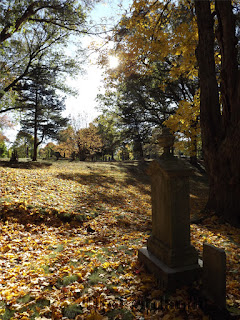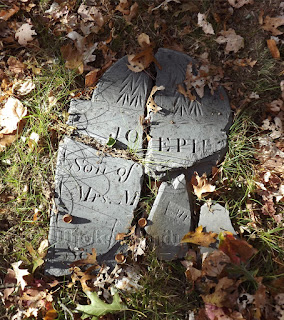If there's one thing Massachusetts is good for, it's old cemeteries, and if there's another, it's autumn. In my opinion this is the best time of year to visit a cemetery, because combining the aesthetics of turning, falling leaves with old stone makes for some pretty gorgeous contrasts.
 Once again, I briefly thought of going to Salem this week before my class in Boston. It's still just a bit too far to justify, though, and I wouldn't have had enough time to spend in the burying grounds there. But in the course of looking over my cemetery spreadsheet I noticed a name that's become familiar on my jaunts on the turnpike: Newton. The town is basically in Boston, and only about five miles from campus if the GPS is to be trusted, so I could certainly make a stop there.
Once again, I briefly thought of going to Salem this week before my class in Boston. It's still just a bit too far to justify, though, and I wouldn't have had enough time to spend in the burying grounds there. But in the course of looking over my cemetery spreadsheet I noticed a name that's become familiar on my jaunts on the turnpike: Newton. The town is basically in Boston, and only about five miles from campus if the GPS is to be trusted, so I could certainly make a stop there.East Parish Burying Ground is one of three old cemeteries in Newton. Without having visited the other two, I'm still confident in considering this one the best. It's also the oldest of the three, occupying the spot where the first meetinghouse in Newton was built in 1660--and now across the street from Boston College's law school. Using the school's address for GPS coordinates might be a good idea, since most websites only listed the cemetery's location as the corner of Cotton and Centre Streets; that is indeed where the entrance is.
The only problem with the cemetery is that there isn't anywhere convenient to park. Parking is prohibited except for weekends and holidays on Cotton Street, and some other streets in the neighboring residential area are similarly marked. I figured the law school might not be amenable to foreigners using their lot, so I finally decided to part in front of someone's house around the corner from the cemetery entrance, within sight of a one-hour-parking sign.
The earliest graves are from the 17th century and the latest (and least) from the 20th. The southern end, the section nearest the entrance, seems to have the older graves, and they get newer as you move north. The cemetery isn't all level; there are a few mounds near the entrance that hold mausoleums covered over with grass, and the ground slopes a bit higher above them as you move further in. Then it falls away toward the north. I liked the uneven terrain. It wasn't hilly enough to be too challenging to walk through, but enough to provide interest. And as I'd hoped, there were a few trees in a really prime state of leaf-changing.
 The thing that sets East Parish apart from other cemeteries is the quality of the carvings. Of course there are some toppled stones, and reassembled ones, and lichen-streaked ones, but there are a number of 18th-century slates whose carving is fantastically crisp and fresh. It was almost unbelievable; several of the stones looked like Halloween decorations, both in their design and in their apparent newness. I was really very impressed, and still am a day later. Plus there were some wonderful old names, like Sylvanus Wetherbee, Deliverance Hide, General Michael Jackson, and my favorite, Patience Pigeon.
The thing that sets East Parish apart from other cemeteries is the quality of the carvings. Of course there are some toppled stones, and reassembled ones, and lichen-streaked ones, but there are a number of 18th-century slates whose carving is fantastically crisp and fresh. It was almost unbelievable; several of the stones looked like Halloween decorations, both in their design and in their apparent newness. I was really very impressed, and still am a day later. Plus there were some wonderful old names, like Sylvanus Wetherbee, Deliverance Hide, General Michael Jackson, and my favorite, Patience Pigeon.East Parish had great light, great leaves, and great graves. While you may not be guaranteed the first two on your visit, you'll definitely get the latter. I highly recommend visiting if you can.




No comments:
Post a Comment